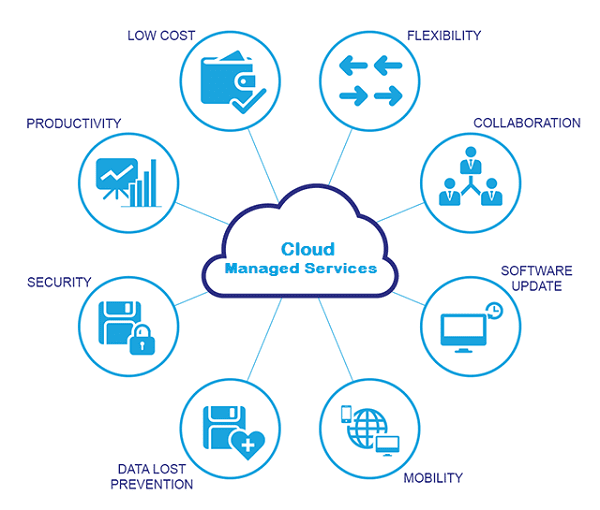4 Benefits of Adopting a Managed Cloud Service
The pandemic has accelerated the move to cloud platforms. Here are a few examples of where cloud can improve the bottom line, from balance sheet to security to data availability.

While uncertainty looms, businesses are looking to cut costs and improve efficiency wherever possible. Simply digitizing assets and digitalizing processes isn’t enough for companies hoping to cut dead weight and grow revenue in 2020 and beyond. To improve gross margins in today’s digital age, enterprises must offload underutilized data servers to reduce costs, outsource mundane infrastructure tasks to simplify workflows, and improve the user experience to increase engagement.
A managed cloud service will do just that: reduce operating costs while empowering businesses to focus on important tasks such as improving customer experience.
1. Reduce Spend with Automatic Scaling
Enterprises managing on-prem data centers are overspending with no guarantee that all or most of the infrastructure will be used. All of the necessary hardware and after-purchase services like setting up new servers, facility fees, and replacement costs for defective hardware add up to a substantial sum. On-prem infrastructures cost millions of dollars in facility management fees, utilities expenses, and legacy server replacements. Kellog’s said that moving to the cloud saves $900,000 in infrastructure costs alone, and lets them run dozens of simulations a day so they can reduce trade spend. With money tied up in underutilized resources, companies are forced to delay other potential business investments that could have long-lasting impacts.

Pricing for managed cloud services allows companies to buy what they use and scale when needed. By switching to a cloud environment, companies are freed from the burden of facility costs and can scale up or down to meet seasonal demands.Think of it like a meal box subscription service like Blue Apron or Hello Fresh. Once I subscribe, I can get weekly groceries and recipes to cook up into a delicious dinner. It saves me time because I don’t have to grocery shop or internet surf for a recipe — super helpful during weeks where I’m trying to avoid unnecessary trips outside.

Then, when I don’t need it anymore, I go on the website and skip a box. Maybe I got a deal on produce at the farmer’s market. I don’t lose the ability to order more meal boxes, I’m just scaling the shipments according to my needs moment to moment. (And a cloud subscription is similar to this and even better because it scales automatically, without anyone needing to remember to click “skip this week”). Companies that instead rely on an on-prem data center get all the meal boxes or none of the meal boxes, and it can take months to adjust.
2. Allow Teams To Focus on What Matters Most
A managed cloud service also allows enterprises to outsource non-specialized work to cloud providers by shifting the responsibility of maintaining and replacing equipment and infrastructure to the managed cloud service provider. This saves capital and allows technologists to focus on tasks associated with revenue-generation, instead of spending time integrating SaaS tools with current systems, scheduling data backups, and monitoring security.
For example, Australia Financial Group (AFG), one of the largest mortgage aggregators in Australia, was able to reduce IT operational costs by more than $370,000 annually and are now spending that money to drive innovation.
3. Ensure High Availability
Managed cloud service providers monitor the status of your data servers and ensure processes experience zero down-time when malfunctions in the data center arise. For example, in the case of a natural disaster, service vendors implement a fail-over system to maintain business as usual without disrupting workflow or other processes. Compare this to a company using an on-prem data center. Similar events would cause the business to lose valuable signal data that powers the user experience, and potentially miss out on high-value sales or damage the brand name.
4. Enjoy High Level Security with Complete Control Over Your Data

Security is one of the most common objections to cloud migration. However, the cloud is less susceptible to security breaches than on-prem infrastructure. Gartner anticipates that cloud infrastructure workloads will suffer at least 60% fewer security incidents this year than on-prem data centers. Third-party security admins do not have access to confidential information, but are able to enhance gateway security and ensure private tokens are given only to credible employees and users within the company. Additionally, cloud-based applications can be easily upgraded with security patches from service providers without time-intensive manual intervention.
Reduce Hardware Footprint, Slash Costs
At Lucidworks we want our customers focusing on the work that differentiates them from their competitors and drives profit and productivity. With a managed cloud service platform, customers can be more agile and responsive, and they’re in direct control of their destiny without being weighed down by costly hardware and maintenance. Learn more about how cloud-native Fusion lets customers easily deploy AI-powered data discovery and search applications to deliver valuable insights to users in their moment of need.
LEARN MORE
Contact us today to learn how Lucidworks can help your team create powerful search and discovery applications for your customers and employees.